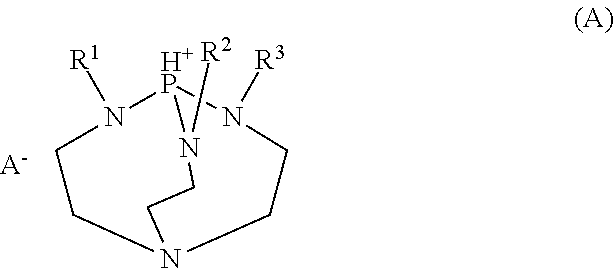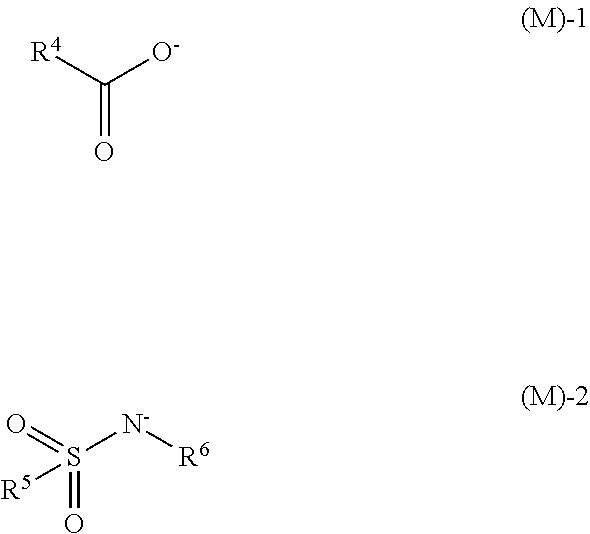Resist composition and patterning process
a composition and patterning technology, applied in the field of resist composition and patterning process, can solve the problems of unsatisfactory performance of the instruments, achieve the effects of wide focus margin, high dissolution contrast, and improve resolution
- Summary
- Abstract
- Description
- Claims
- Application Information
AI Technical Summary
Benefits of technology
Problems solved by technology
Method used
Image
Examples
example
[0140]Examples of the invention are given below by way of illustration and not by way of limitation. The abbreviation “pbw” is parts by weight. For all polymers, Mw and Mn are determined by GPC versus polystyrene standards using tetrahydrofuran solvent, and dispersity Mw / Mn is computed therefrom.
[0141]Quenchers 1 to 13 in the form of 2,5,8,9-tetraaza-1-phosphabicyclo[3.3.3]undecane salt compounds used herein have the following structure. Quenchers 1 to 13 were synthesized by mixing a 2,5,8,9-tetraaza-1-phosphabicyclo[3.3.3]undecane compound to provide the illustrated cation with a carboxylic acid, sulfonimide, nitric acid, hydrochloric acid or hydroiodic acid to provide the illustrated anion.
synthesis example
[0142]Synthesis of Polymers 1 to 6
[0143]Base polymers were prepared by combining suitable monomers, effecting copolymerization reaction thereof in tetrahydrofuran solvent, pouring the reaction solution into methanol for crystallization, repeatedly washing with hexane, isolation, and drying. The resulting polymers, designated Polymers 1 to 6, were analyzed for composition by 1H-NMR, and for Mw and Mw / Mn by GPC.
examples 1-1 to 1-14
and Comparative Examples 1-1 to 1-5
[0151]On a substrate (silicon wafer), a spin-on carbon film ODL-102 (Shin-Etsu Chemical Co., Ltd.) having a carbon content of 80 wt % was deposited to a thickness of 200 nm and a silicon-containing spin-on hard mask SHB-A940 having a silicon content of 43 wt % was deposited thereon to a thickness of 35 nm. On this substrate for trilayer process, each of the resist compositions in Table 1 was spin coated, then baked on a hot plate at 100° C. for 60 seconds to form a resist film of 80 nm thick.
[0152]Using an ArF excimer laser immersion lithography scanner NSR-S610C (Nikon Corp., NA 1.30, a 0.98 / 0.78, 35° cross-pole illumination, azimuthally polarized illumination), the resist film was exposed through a 6% halftone phase shift mask bearing a pattern having a line of 60 nm and a pitch of 200 nm (on-wafer size). The resist film was baked (PEB) at the temperature shown in Table 1 for 60 seconds and immediately developed in n-butyl acetate for 30 seconds,...
PUM
 Login to View More
Login to View More Abstract
Description
Claims
Application Information
 Login to View More
Login to View More - R&D
- Intellectual Property
- Life Sciences
- Materials
- Tech Scout
- Unparalleled Data Quality
- Higher Quality Content
- 60% Fewer Hallucinations
Browse by: Latest US Patents, China's latest patents, Technical Efficacy Thesaurus, Application Domain, Technology Topic, Popular Technical Reports.
© 2025 PatSnap. All rights reserved.Legal|Privacy policy|Modern Slavery Act Transparency Statement|Sitemap|About US| Contact US: help@patsnap.com



